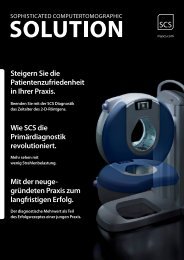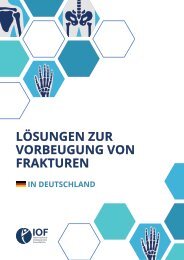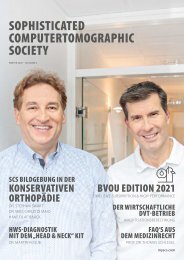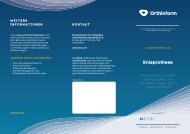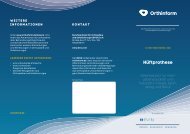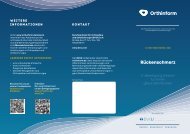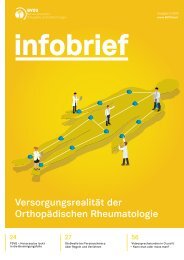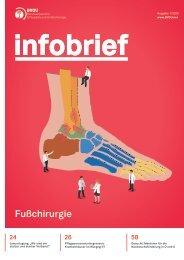Fracture Prevention in Germany 2024
Erfolgreiche ePaper selbst erstellen
Machen Sie aus Ihren PDF Publikationen ein blätterbares Flipbook mit unserer einzigartigen Google optimierten e-Paper Software.
SOLUTIONS FOR<br />
FRACTURE PREVENTION<br />
IN GERMANY
partnership<br />
February <strong>2024</strong><br />
German experts:<br />
Dr. Björn Bühr<strong>in</strong>g (Krankenhaus St. Joseph), Prof. Wolfgang Böcker<br />
(Ludwig-Maximilians-Universität München), Prof. Peyman Hadji (Frankfurt<br />
Center of Bone Health & Universität Marburg), Dr. Eric Hesse (Universität<br />
LMU München), Prof. Andreas Kurth (St. Marien Krankenhaus Ma<strong>in</strong>z),<br />
Dr. Uwe Maus (Universitätskl<strong>in</strong>ikum Düsseldorf), Prof. Christopher<br />
Niedhart (Kl<strong>in</strong>ik Christopher Niedhart), Dr. Stephan Semisch (Mediz<strong>in</strong>ische<br />
Hochschule Hannover), Dr. Richard Stange (Institut für Muskuloskelettale<br />
Mediz<strong>in</strong>)<br />
IOF-CTF policy group:<br />
Ass. Prof. Nicholas Fuggle (University of Southampton), Prof. Cyrus<br />
Cooper (University of Southampton); Ass. Prof. Kassim Javaid (University<br />
of Oxford), Ass. Prof Rafael P<strong>in</strong>edo-Villanueva (University of Oxford),<br />
Ass. Prof Mickael Hiligsmann (Maastricht University), Anastasia Soulié-<br />
Mlotek (International Osteoporosis Foundation), Dr. Philippe Halbout<br />
(International Osteoporosis Foundation)<br />
Report compiled by the International Osteoporosis Foundation<br />
(IOF) under the umbrella of Capture the <strong>Fracture</strong> ® <strong>in</strong>itiative (CTF),<br />
<strong>in</strong> collaboration with German bone health experts.
CONTENTS<br />
1<br />
Summary<br />
Page 5<br />
2<br />
A problem on the rise<br />
Page 8<br />
3<br />
Successes and<br />
missed opportunities<br />
Page 12<br />
4<br />
Solutions exist:<br />
Policy recommendations<br />
Page 15<br />
5<br />
Build your response<br />
Page 16<br />
6<br />
Glossary<br />
Page 20<br />
3
Summary 1<br />
SUMMARY<br />
This document provides an assessment of the current policy and postfracture<br />
care landscape <strong>in</strong> <strong>Germany</strong>, and provides recommendations<br />
which are aligned to the needs and opportunities identified by the<br />
Capture the <strong>Fracture</strong> ® Partnership <strong>in</strong> cooperation with a panel of German<br />
experts.<br />
This document aims to:<br />
SECTION 1 - A Problem on the Rise<br />
Summarize the <strong>in</strong>creas<strong>in</strong>g burden of fragility fractures <strong>in</strong> <strong>Germany</strong><br />
SECTION 2 - Successes and Missed Opportunities<br />
Map out successful post-fracture care <strong>in</strong>itiatives <strong>in</strong> <strong>Germany</strong>, and identify areas for improvement<br />
SECTION 3 - Solutions Exist: Policy Recommendations<br />
Provide health policy recommendations to address the burden of osteoporosis and fragility fractures<br />
and drive their implementation<br />
SECTION 4 - Build Your Response<br />
Support local stakeholders <strong>in</strong> prioritis<strong>in</strong>g osteoporosis and fragility fractures<br />
5
1<br />
Summary<br />
Key Messages<br />
Grow<strong>in</strong>g burden of osteoporosis, <strong>in</strong>creas<strong>in</strong>g treatment gap, importance of the<br />
disease management program and of secondary fracture prevention<br />
a.<br />
Fragility fractures are a major public health concern <strong>in</strong> <strong>Germany</strong><br />
and are associated with a substantial (and escalat<strong>in</strong>g) health and f<strong>in</strong>ancial<br />
burden. Approximately 831,000 fragility fractures occurred <strong>in</strong> the year 2019<br />
and osteoporosis-related costs were estimated at €13.8 billion <strong>in</strong> the same<br />
year. With an age<strong>in</strong>g population and no change <strong>in</strong> policy, the number of<br />
fragility fractures is expected to <strong>in</strong>crease by more than 16% over the next<br />
15 years.<br />
b.<br />
Osteoporosis rema<strong>in</strong>s largely underdiagnosed and undertreated.<br />
Today, more than 2.4 million German women who are at high risk of<br />
fracture rema<strong>in</strong> untreated for osteoporosis, despite the existence of safe<br />
and effective medications. Furthermore, all patients are <strong>in</strong>sured (by law)<br />
and therefore no restriction with regard to treatment at least for oral<br />
bisphosphonates exists. Despite this, osteoporosis is rarely diagnosed<br />
although bone m<strong>in</strong>eral density assessment is available nationwide.<br />
Poor treatment <strong>in</strong>itiation is especially marked <strong>in</strong> high-risk patients with<br />
about two-thirds of German patients not currently receiv<strong>in</strong>g effective<br />
secondary fracture prevention after an <strong>in</strong>itial fragility fracture, despite this<br />
population be<strong>in</strong>g at highest risk of further fracture.<br />
c.<br />
Insufficient fund<strong>in</strong>g of the Osteoporosis Disease Management<br />
Program (DMP) by health <strong>in</strong>surers. Although the DMP was approved<br />
by the responsible authority (Federal Jo<strong>in</strong>t Committee, GBA) <strong>in</strong> 2020, no<br />
fund<strong>in</strong>g was made available until the end of 2023, which is slow<strong>in</strong>g down<br />
the desired improvement <strong>in</strong> care. S<strong>in</strong>ce 2020, patients diagnosed with<br />
osteoporosis could be treated as part of a structured treatment program<br />
called DMP. The DMP osteoporosis is aimed at women and men aged<br />
50 and over with a diagnosis of osteoporosis, which can be treated with<br />
medication, among other th<strong>in</strong>gs, <strong>in</strong> accordance with the DVO guidel<strong>in</strong>es,<br />
and is particularly aimed at prevent<strong>in</strong>g falls and (further) fractures.<br />
This is an important first step towards prevent<strong>in</strong>g age-related fractures<br />
<strong>in</strong> patients.<br />
d.<br />
The German population is underserved with Post <strong>Fracture</strong> Care<br />
(PFC) services. Despite the recognized benefits of FLS (a model of<br />
Post <strong>Fracture</strong> Care) <strong>in</strong> reduc<strong>in</strong>g the risk of fractures, only 1-10% of<br />
the hospitals <strong>in</strong> <strong>Germany</strong> (as described <strong>in</strong> the SCOPE 2021 report)<br />
were reported to have an FLS. This represents a substantial missed<br />
opportunity, as it is a well-known fact that those who have had one<br />
fracture are vastly more likely to have another, and that target<strong>in</strong>g<br />
treatment <strong>in</strong> this group through FLS is a viable, and high-yield place<br />
to start. However, several German hospitals have implemented<br />
orthogeriatric services for the management of patients with fractures.<br />
6
Summary 1<br />
Key Recommendations<br />
Although several <strong>in</strong>itiatives are already <strong>in</strong> place and need to be re<strong>in</strong>forced,<br />
specific recommendations <strong>in</strong>clude:<br />
1.<br />
Pass<strong>in</strong>g regulations and/or provid<strong>in</strong>g f<strong>in</strong>ancial <strong>in</strong>centives to fund and<br />
support FLS <strong>in</strong>frastructure<br />
2.<br />
Emphasis<strong>in</strong>g post-fracture care with osteoporosis treatment as a priority<br />
of healthcare management<br />
3.<br />
Roll<strong>in</strong>g out a larger number of FLS to <strong>in</strong>crease post-fracture screen<strong>in</strong>g,<br />
diagnosis and treatment rates<br />
4.<br />
Improv<strong>in</strong>g awareness <strong>in</strong> the medical field as well as <strong>in</strong> the public sphere<br />
of osteoporosis
2<br />
A problem on the rise<br />
A PROBLEM ON THE RISE<br />
Osteoporosis is a disease which makes bones weak and fragile. This<br />
greatly <strong>in</strong>creases the risk of break<strong>in</strong>g a bone even after a m<strong>in</strong>or fall or<br />
bump. The disease has no obvious symptoms, and many people do not<br />
know they have osteoporosis until they suffer a fracture.<br />
Figure 1<br />
Burden of osteoporosis-related fractures<br />
<strong>in</strong> <strong>Germany</strong> (ScoreCard for Osteoporosis<br />
<strong>in</strong> Europe, 2021)<br />
These, osteoporotic ‘fragility fractures’ are common, particularly <strong>in</strong> older<br />
adults, are <strong>in</strong>creas<strong>in</strong>g <strong>in</strong> prevalence, can be life-alter<strong>in</strong>g, caus<strong>in</strong>g pa<strong>in</strong>,<br />
disability and loss of <strong>in</strong>dependence, and are associated with a substantial<br />
direct and <strong>in</strong>direct f<strong>in</strong>ancial burden. Figure 1 summarizes key data<br />
regard<strong>in</strong>g the burden of osteoporosis and fractures <strong>in</strong> <strong>Germany</strong>.<br />
BURDEN OF DISEASE<br />
831,000<br />
NEW FRAGILITY FRACTURES IN 2019<br />
2,300 95<br />
FRACTURES FRACTURES<br />
PER DAY<br />
PER HOUR<br />
CHANGE IN COST PER INDIVIDUAL<br />
€121.4<br />
2010<br />
€166.8<br />
2019<br />
+37%<br />
5,659,000<br />
INDIVIDUALS WITH OSTEOPOROSIS IN 2019<br />
79.5%<br />
WOMEN<br />
20.5%<br />
MEN<br />
6.1% OF THE TOTAL POPULATION<br />
€13.8 €3.35 €10.24 €249 967,000<br />
BILLION BILLION MILLION<br />
831,000<br />
BILLION<br />
SPENT IN 2019<br />
LONG-TERM<br />
DISABILITY COSTS<br />
DIRECT COST OF<br />
INCIDENT<br />
FRACTURES<br />
PHARMACOLOGICAL<br />
INTERVENTION<br />
HUGE COST BURDEN FOR OSTEOPOROSIS-RELATED HEALTHCARE<br />
PROJECTED INCREASE IN THE NUMBER OF<br />
FRAGILITY FRACTURES<br />
+16.4%<br />
2019<br />
2034<br />
Population age<strong>in</strong>g<br />
Increase of the age<strong>in</strong>g population. Currently, <strong>in</strong> <strong>Germany</strong>, the average<br />
life expectancy is 83.4 years for women and 78.5 years for men. In 2006,<br />
the over 65s made up 19% of the population, which will rise to more than<br />
30% by 2050.<br />
This shift <strong>in</strong> demographics will markedly <strong>in</strong>crease the <strong>in</strong>cidence and<br />
societal burden of fragility fractures with<strong>in</strong> the population.<br />
8
A problem on the rise 21<br />
<strong>Fracture</strong>s are common<br />
Fragility fractures are a substantial public health issue. In 2019,<br />
about 831,000 fractures occurred <strong>in</strong> <strong>Germany</strong> (approximately 95<br />
fractures per hour).<br />
Fragility fractures affect numerous women and men. It has been<br />
reported that nearly 5.6 million <strong>in</strong>dividuals (<strong>in</strong>clud<strong>in</strong>g 4.5 million women)<br />
are liv<strong>in</strong>g with osteoporosis <strong>in</strong> <strong>Germany</strong> (represent<strong>in</strong>g 5.4% of the total<br />
population). The prevalence of osteoporosis <strong>in</strong> the over 50s is 23% for<br />
women and 7% for men. Another study us<strong>in</strong>g a German claims database<br />
reported a 16% overall prevalence of osteoporosis <strong>in</strong> persons ≥50 years<br />
of age. Furthermore, the lifetime risk of hip fracture (the most serious<br />
fracture type) from age 50 is 14% <strong>in</strong> women and 5% <strong>in</strong> men.<br />
WOMEN<br />
+50<br />
YEARS<br />
MEN<br />
23%<br />
+50<br />
7%<br />
YEARS<br />
Fragility fractures are on the rise. With life expectancy cont<strong>in</strong>u<strong>in</strong>g to<br />
<strong>in</strong>crease, fragility fracture <strong>in</strong>cidence <strong>in</strong> <strong>Germany</strong> is predicted to <strong>in</strong>crease<br />
by 16% <strong>in</strong> the next 15 years.<br />
Re-fractures are also on the rise. It is well recognised that the risk of<br />
further fractures after an <strong>in</strong>itial fracture is significantly higher. A German<br />
study <strong>in</strong>clud<strong>in</strong>g about 18,000 fracture patients demonstrated that<br />
subsequent fractures occurred <strong>in</strong> 16% of patients dur<strong>in</strong>g a 1-year followup<br />
period. In another German study <strong>in</strong>clud<strong>in</strong>g about 145,000 patients<br />
aged ≥70 years 30% of patients had at least one subsequent fracture<br />
dur<strong>in</strong>g a median follow-up of 3.2 years.<br />
Fragility fractures are associated with <strong>in</strong>creased death. A German<br />
study <strong>in</strong>clud<strong>in</strong>g more than 120,000 patients aged 65 years and older with<br />
hip fractures showed that 21% of the patients died with<strong>in</strong> 6 months and<br />
28% with<strong>in</strong> 12 months.<br />
TWELVE-MONTH<br />
HIP<br />
FRACTURE<br />
MORTALITY<br />
SIX-MONTH<br />
28% HIP 21%<br />
FOR PATIENTS<br />
FRACTURE<br />
FOR PATIENTS<br />
AGED +65 MORTALITY AGED +65<br />
Fragility fractures cause pa<strong>in</strong>, disability, loss of <strong>in</strong>dependence, and<br />
have a significant impact on quality of life. In <strong>Germany</strong>, an estimated<br />
24 years are lost due to disability (disability-adjusted life years, DALY) due<br />
to fragility fractures, per 1,000 <strong>in</strong>dividuals aged over 50 years.<br />
9
2<br />
A problem on the rise<br />
F<strong>in</strong>ancial impact<br />
Fragility fractures are costly to the healthcare system. In 2019, the<br />
total related burden for osteoporosis was estimated at €13.8 billion,<br />
<strong>in</strong>clud<strong>in</strong>g €10.2 billion for direct costs of <strong>in</strong>cident fractures, €3.4 billion for<br />
long-term disability costs and €249 million for pharmacological treatment.<br />
The f<strong>in</strong>ancial burden is on the rise. The cost of fragility fractures per<br />
<strong>in</strong>habitant has <strong>in</strong>creased by 37% between 2010 (€121) and 2019 (€167).<br />
Due to the age<strong>in</strong>g population, the direct costs of <strong>in</strong>cident fractures are<br />
predicted to <strong>in</strong>crease by more than 25% <strong>in</strong> the next 15 years.<br />
€13.8<br />
BILLION<br />
SPENT IN 2019<br />
€3.35<br />
BILLION<br />
LONG-TERM<br />
DISABILITY COSTS<br />
€10.24<br />
BILLION<br />
DIRECT COST OF<br />
INCIDENT FRACTURES<br />
€249<br />
MILLION<br />
PHARMACOLOGICAL<br />
TREATMENT<br />
Fragility fractures do not just affect national f<strong>in</strong>ances directly, but<br />
also <strong>in</strong>directly through fractures <strong>in</strong> the workforce and the additional care<br />
required from family and relatives of work<strong>in</strong>g age. Although the majority<br />
of fragility fractures affect those <strong>in</strong> later life, 20% of fractures occur prior<br />
to retirement. Us<strong>in</strong>g a simulation model, a German study reported that<br />
<strong>in</strong>direct costs represented 16% of the total burden of fractures <strong>in</strong> 2010, a<br />
proportion that is expected to <strong>in</strong>crease to 22% <strong>in</strong> 2050.<br />
Fragility fractures <strong>in</strong> <strong>Germany</strong> generate a legacy of f<strong>in</strong>ancial<br />
burden with 12% of patients aged 50 or above who suffer a hip<br />
fracture be<strong>in</strong>g <strong>in</strong>stitutionalized with<strong>in</strong> 6 months of discharge from<br />
hospital (this is a higher risk compared to stroke, myocardial <strong>in</strong>farction,<br />
pneumonia or a comb<strong>in</strong>ed group of all other hospitalizations). The risk<br />
of <strong>in</strong>stitutionalization <strong>in</strong>creased exponentially with age with risk due to a<br />
femoral fracture <strong>in</strong>creas<strong>in</strong>g from 3.6% <strong>in</strong> women aged 65 to 69 years to<br />
34.8% <strong>in</strong> women aged 95 years and older.<br />
10
11
3<br />
Successes and missed opportunities<br />
SUCCESSES AND<br />
MISSED OPPORTUNITIES<br />
We have identified positive <strong>in</strong>itiatives to be re<strong>in</strong>forced and missed<br />
opportunities which should be seized.<br />
Positive <strong>in</strong>itiatives to be<br />
built upon<br />
Approval of the Disease Management Program for osteoporosis.<br />
Despite its approval, so far, it has not received any fund<strong>in</strong>g by health<br />
<strong>in</strong>surers. Probably <strong>in</strong> 2023, patients diagnosed with osteoporosis<br />
requir<strong>in</strong>g medication will be able to receive care with<strong>in</strong> a structured DMP.<br />
With the osteoporosis DMP, the disease will be elevated to its justified<br />
status as one of the most important chronic and progressive conditions.<br />
Guidel<strong>in</strong>es for the management of osteoporosis are available <strong>in</strong><br />
<strong>Germany</strong> with a focus on different demographics: postmenopausal<br />
women, osteoporosis <strong>in</strong> men, secondary osteoporosis <strong>in</strong>clud<strong>in</strong>g<br />
glucocorticoid-<strong>in</strong>duced osteoporosis. <strong>Germany</strong> has its own risk<br />
assessment guidel<strong>in</strong>es (DVO) that are universally adopted.<br />
Robust collection of data <strong>in</strong> the national hip fracture registry. This<br />
<strong>in</strong>itiative is highly functional and rigorously updated, not only with hip<br />
fracture data but also data perta<strong>in</strong><strong>in</strong>g to other fragility fracture types.<br />
Value of a coord<strong>in</strong>ated management of osteoporosis via FLS. A<br />
German study revealed that FLS led to more people be<strong>in</strong>g diagnosed with<br />
osteoporosis and a higher rate of osteoporotic treatment.<br />
German health <strong>in</strong>surance offers full reimbursement for osteoporosis<br />
medications. Furthermore, the estimated average wait<strong>in</strong>g time for<br />
DXA is short and the reimbursement for DXA is available. While DXA<br />
reimbursement exists, it is so low that many providers who have a DXA<br />
scanner do not apply for health <strong>in</strong>surance reimbursement but rather<br />
offer it to patients as an “<strong>in</strong>dividual health service” that the patient has to<br />
pay for out of their own pocket.<br />
12
Successes and missed opportunities 31<br />
Strength <strong>in</strong> collaboration. There are a substantial number of<br />
organizations active <strong>in</strong> the bone field. All German scientific societies<br />
active <strong>in</strong> the bone field are currently <strong>in</strong>tegrated <strong>in</strong> an “Umbrella<br />
Organization of German Scientific Societies of Osteology - Dachverband<br />
Deutschsprachiger Wissenschaftlicher Gesellschaften für Osteologie,<br />
DVO e.V”. In addition, all patient advocacy organisations are merged <strong>in</strong>to<br />
an umbrella organisation, the OSD, Osteoporose Selbsthilfegruppen<br />
Dachverband e.V. These groups cover three particular areas of advocacy<br />
<strong>in</strong>clud<strong>in</strong>g policy, capacity and peer support.<br />
Gaps and missed opportunities<br />
761,000<br />
WOMEN TREATED<br />
FOR OSTEOPOROSIS<br />
3,238,000<br />
WOMEN ELIGIBLE FOR<br />
OSTEOPOROSIS TREATMENT<br />
2,477,000<br />
WOMEN<br />
REMAIN UNTREATED FOR<br />
OSTEOPOROSIS<br />
76%<br />
TREATMENT GAP<br />
Figure 2<br />
Treatment gap <strong>in</strong> German women<br />
(ScoreCard for Osteoporosis <strong>in</strong> Europe,<br />
2021)<br />
More than 3.2 million German women who are at high risk of<br />
fracture rema<strong>in</strong> untreated for osteoporosis, despite available effective<br />
and safe medications. A recent German observational study confirmed<br />
that cont<strong>in</strong>ued treatment with osteoporosis medication was associated<br />
with reductions of fracture rates <strong>in</strong> a real-world sett<strong>in</strong>g.<br />
High treatment gap. The SCOPE study reported an estimated 76% of<br />
German women (aged 50 years and above) eligible for osteoporosis<br />
treatment do not currently receive preventative treatment after an <strong>in</strong>itial<br />
fragility fracture. This gap is similar to 2010 (77%), reflect<strong>in</strong>g the lack<br />
of development and progress <strong>in</strong> post-facture care. This estimation is<br />
similar to a recent German study revweal<strong>in</strong>g that among persons with<br />
an osteoporosis diagnosis, an osteoporotic fracture, or a diagnosis of<br />
osteoporosis and/or osteoporotic fracture, 31%, 22% and 30% received<br />
an osteoporosis-specific prescription, respectively.<br />
Poor medication <strong>in</strong>take and adherence, even after previous<br />
fragility fracture. Those who have had one fracture are highly likely to<br />
susta<strong>in</strong> another. Despite this, only 20% to 40% of German women are<br />
commenced on anti-osteoporosis treatment with<strong>in</strong> the first year of an<br />
osteoporotic fracture. Furthermore, 2-year persistence with osteoporosis<br />
medications is estimated to lie between 17% and 40%.<br />
13
3<br />
Successes and missed opportunities<br />
Too few FLS <strong>in</strong>itiatives are currently operational. Despite the benefits<br />
of FLS <strong>in</strong> reduc<strong>in</strong>g the risk of fractures and cost-sav<strong>in</strong>g, FLS are only<br />
present <strong>in</strong> 1-10% of hospitals <strong>in</strong> <strong>Germany</strong> (as described <strong>in</strong> the SCOPE<br />
2021 report).<br />
ONLY<br />
1-10%<br />
OF GERMAN<br />
HOSPITALS<br />
HAVE A<br />
SERVICE<br />
FRACTURE<br />
LIAISON<br />
As of February <strong>2024</strong>, there are 2 FLS centres follow<strong>in</strong>g International<br />
Osteoporosis Foundation & Capture the <strong>Fracture</strong> ® guidel<strong>in</strong>es, <strong>in</strong>clud<strong>in</strong>g,<br />
1 silver star, and 1 blue star service.<br />
2<br />
AS OF<br />
CENTERS FEBRUARY <strong>2024</strong> 1 1<br />
Lack of f<strong>in</strong>ancial support from government and health <strong>in</strong>surance<br />
companies. Despite the approval of the DMP for osteoporosis, it has<br />
organisational and fund<strong>in</strong>g issues, and is therefore not yet underway.<br />
Inconsistent patient and treatment pathway. There is currently no<br />
consistent implementation of a robust treatment pathway to ensure<br />
adequate post-discharge care and transition to primary care. This<br />
is further re<strong>in</strong>forced by a split between hospital and office-based<br />
sett<strong>in</strong>gs regard<strong>in</strong>g the diagnosis and treatment of osteoporosis. Most<br />
osteoporosis care is supposed to be provided by private practice<br />
orthopaedic surgeons, opposite to many other countries where this care<br />
is <strong>in</strong> the hands of primary care and/or <strong>in</strong>ternal medic<strong>in</strong>e. The silo-based<br />
care is an important challenge <strong>in</strong> <strong>Germany</strong>. F<strong>in</strong>ancial compensation is<br />
further very low for a patient with osteoporosis.<br />
Lack of electronic shar<strong>in</strong>g system and obstacles on multidiscipl<strong>in</strong>ary<br />
collaboration. There is no system <strong>in</strong> place to electronically share patient<br />
<strong>in</strong>formation. Each private practice has their own electronic medical<br />
record that is not l<strong>in</strong>ked to the hospitals or other practices. As such,<br />
<strong>in</strong>formation of previous fractures, co-morbidities, lab and imag<strong>in</strong>g results<br />
and previous treatments does not get exchanged. Hospitals and private<br />
practices are afraid other providers / hospitals will “steal” their patients.<br />
14
Solutions exist: Policy recommendations 4<br />
SOLUTIONS EXIST:<br />
POLICY RECOMMENDATIONS<br />
Specific policy recommendations <strong>in</strong>clude:<br />
1<br />
F<strong>in</strong>ancial<br />
<strong>in</strong>centives for osteoporosis care<br />
• Fund<strong>in</strong>g / reimbursement structure for discharge management of<br />
patient fragility fractures (e.g. FLS nurse).<br />
• Incentives for hospitals and private practice physicians to develop FLS.<br />
• Hospital managers, primary care managers and private practice<br />
physicians currently should receive <strong>in</strong>centives to treat patients with<br />
osteoporosis and develop FLS.<br />
2<br />
Optimiz<strong>in</strong>g patient and treatment pathway<br />
• Increas<strong>in</strong>g the number of patients who receive an osteoporotic<br />
treatment dur<strong>in</strong>g <strong>in</strong>patient care and optimised discharge<br />
management to guide patient care follow<strong>in</strong>g discharge from hospital.<br />
• Interdiscipl<strong>in</strong>ary collaboration required to develop optimum<br />
treatment strategies as bone health crosses many medical discipl<strong>in</strong>es.<br />
3<br />
4<br />
Facilitate greater FLS uptake to <strong>in</strong>crease post-fracture screen<strong>in</strong>g, diagnosis and treatment rates<br />
Increas<strong>in</strong>g public awareness of osteoporosis<br />
• Extra support (logistically and f<strong>in</strong>ancially) from health <strong>in</strong>surances.<br />
• More data on the efficiency of FLS with<strong>in</strong> German policy would <strong>in</strong>form<br />
future practice<br />
• Public awareness of osteoporosis should be improved through a<br />
suite of engagement activities.<br />
15
5<br />
Build your response<br />
BUILD YOUR RESPONSE<br />
Disease management program<br />
• Although the disease management program is an important<br />
first step towards better post-fracture care for patients, f<strong>in</strong>ancial<br />
<strong>in</strong>centives are necessary to fund FLS both on the hospital and<br />
private practice side.<br />
• Regulations/laws that make FLS mandatory <strong>in</strong> centres that take care<br />
of osteoporotic fractures would be recommended.<br />
F<strong>in</strong>d and treat your fractures<br />
(through <strong>in</strong>creased availability of FLS)<br />
• Employ and improve the <strong>in</strong>frastructure already <strong>in</strong> place.<br />
<strong>Germany</strong> still has a very small number of FLS on the CTF map.<br />
Coalition of these facilities would strengthen the CTF message and<br />
potentially improve patient outcomes.<br />
• Shift national and medical op<strong>in</strong>ion of fragility fractures<br />
and osteoporosis among patients, cl<strong>in</strong>icians and hospital<br />
managers and enforce the concept that it is a disease which<br />
requires management and can be treated. This will require<br />
specific <strong>in</strong>volvement from rheumatology, endocr<strong>in</strong>ology, geriatrics,<br />
orthopaedics, <strong>in</strong>ternal medic<strong>in</strong>e, gynaecology, radiology, nurses,<br />
physical medic<strong>in</strong>e and rehabilitation and primary care physicians.<br />
• Facilitate and improve the development of FLS and additional<br />
network structures to improve diagnosis and treatment rates.<br />
Draw on the resources and guidance from the IOF/CTF to develop<br />
German policies, foster coalition, improve mentorship, and utilize FLS<br />
databases (as described below).<br />
Make use of available resources<br />
The International Osteoporosis Foundation has developed several tools<br />
to facilitate and improve the development of Post <strong>Fracture</strong> Care/FLS<br />
<strong>in</strong>clud<strong>in</strong>g:<br />
16
Build your response 5<br />
1. The Policy Toolkit which is a CTF-P Guidance for Policy Shap<strong>in</strong>g<br />
generic narrative and associated resources (slide kit <strong>in</strong> several<br />
languages, Executive Summary, Infographic, web<strong>in</strong>ar, outl<strong>in</strong>e video<br />
and policy toolkit. https://www.capturethefracture.org/resourcecenter/advocat<strong>in</strong>g-for-pfc/policy-toolkits<br />
2. The Capture the <strong>Fracture</strong> ® Resource Centre<br />
(https://www.capturethefracture.org/resource-center) which provides<br />
tools and resources to achieve the follow<strong>in</strong>g:<br />
• Implement<strong>in</strong>g an FLS<br />
• Improv<strong>in</strong>g an FLS<br />
• Advocat<strong>in</strong>g for the development of FLS<br />
The Capture the <strong>Fracture</strong> ® programme provides tools and resources<br />
to optimise post-fracture care:<br />
1. The Best Practice Framework<br />
• Provides guidance for <strong>in</strong>stitutions that are implement<strong>in</strong>g FLS<br />
• Sets benchmark<strong>in</strong>g criteria to stimulate quality improvement of<br />
post-fracture care services at the organisational level<br />
2. The Mentorship Program which partners experienced partners of<br />
FLS with newly formed services<br />
3. The Benefit Calculator: a microsimulation tool to estimate the<br />
f<strong>in</strong>ancial consequences of improv<strong>in</strong>g post-fracture care.<br />
17
5<br />
Build your response<br />
Re<strong>in</strong>force your evidence base<br />
• Real-world studies. Collect<strong>in</strong>g more real-world data could re<strong>in</strong>force<br />
the evidence base regard<strong>in</strong>g the burden of osteoporosis and<br />
challenges. For example, the BEST-II Study of the IPAM project,<br />
performed with real-world data which focused on the proportion<br />
of untreated patients and the high rate of subsequent fractures<br />
<strong>in</strong> <strong>Germany</strong> acts as an encouragement for future collaborative,<br />
epidemiological endeavours.<br />
• Utilise the benefits calculator to assess the expected f<strong>in</strong>ancial<br />
impact of <strong>in</strong>terventions to ensure you stay on track and utilise the<br />
extensive resources available.<br />
Form a policy team<br />
• Use renowned (<strong>in</strong>ter)national mentors/collaborators to educate<br />
and monitor the implementation of fragility fracture care pathways<br />
and FLS development. Invit<strong>in</strong>g all the relevant key players <strong>in</strong> FLS to<br />
participate <strong>in</strong> events which would consolidate collaboration over the<br />
longer term.<br />
• The mentor<strong>in</strong>g program should focus on how to approach key<br />
stakeholders and conv<strong>in</strong>ce them of the potential benefits of FLS.<br />
• Promote <strong>in</strong>tegrated care models; specialist doctors, primary care<br />
doctors, nurses and community pharmacists which facilitate the<br />
evaluation and treatment of patients with bone fragility fractures.<br />
• Policy recommendations for susta<strong>in</strong>able PFC services should<br />
<strong>in</strong>volve approach<strong>in</strong>g key fund<strong>in</strong>g stakeholders <strong>in</strong>clud<strong>in</strong>g the<br />
Regional Authorities, major payers like AOKen, KVen, M<strong>in</strong>istry of<br />
Health of major Federal States like Bavaria and NRW etc.<br />
• Involve ‘key players’ for advocacy <strong>in</strong>clud<strong>in</strong>g “Dachverband<br />
Deutschsprachiger Wissenschaftlicher Gesellschaften für Osteologie”<br />
and the “Bundesselbsthilfeverband für Osteoporose” (BfO) etc.<br />
Engage the public<br />
• Engage patient support groups and the public at large with<br />
education resources and high-quality literature.<br />
18
Build your response 5<br />
Foster healthy age<strong>in</strong>g<br />
• Empower cl<strong>in</strong>icians and persuade health care managers and<br />
professionals that healthy skeletal age<strong>in</strong>g is possible, and that<br />
chronic bone conditions can be managed to prevent future fractures.<br />
• The vital importance of adherence to prolonged drug therapy<br />
should be highlighted and the positive outcomes for therapy<br />
adherence emphasized.<br />
19
6<br />
Glossary<br />
GLOSSARY<br />
FRACTURE – a broken bone<br />
FRAGILITY FRACTURE - A broken bone which occurs due to m<strong>in</strong>or<br />
force, such as a fall from stand<strong>in</strong>g height. The risk of fragility fractures<br />
can be reduced by lifestyle modifications, supplementation of calcium<br />
and vitam<strong>in</strong> D, falls prevention programmes and anti-osteoporosis<br />
medication.<br />
FRACTURE LIAISON SERVICE (FLS) - See Post-<strong>Fracture</strong> Care Coord<strong>in</strong>ation<br />
Programme. A model of care which seeks to rehabilitate <strong>in</strong>dividuals after<br />
they have had a fracture and reduce the risk of them fractur<strong>in</strong>g aga<strong>in</strong> <strong>in</strong><br />
the future. The term is <strong>in</strong>terchangeable with POST-FRACTURE CARE (PFC)<br />
COORDINATION PROGRAMME.<br />
OSTEOPOROSIS - Osteoporosis is a disease <strong>in</strong> which the mass, density<br />
and strength of bone are reduced. As bones become more porous and<br />
fragile, the risk of fracture is greatly <strong>in</strong>creased. The loss of bone occurs<br />
silently and progressively. It primarily affects the elderly and is more<br />
common <strong>in</strong> women than <strong>in</strong> men.<br />
PRIMARY PREVENTION OF FRACTURES - Initiatives to prevent a first/<br />
sent<strong>in</strong>el/<strong>in</strong>itial fracture occurr<strong>in</strong>g.<br />
SECONDARY PREVENTION OF FRACTURES - Initiatives to prevent<br />
second/subsequent/further fractures occurr<strong>in</strong>g after the first fracture has<br />
occurred.<br />
DALY (DISABILITY ADJUSTED LIFE YEARS) - a measure of overall disease<br />
burden expressed as the number of years lost due to disability or early<br />
death. One DALY represents the loss of the equivalent of one year of full<br />
health.<br />
20
References<br />
Bleibler F, Konnopka A, Benz<strong>in</strong>ger P, et al. (2013). The health burden and costs of <strong>in</strong>cident fractures attributable<br />
to osteoporosis from 2010 to 2050 <strong>in</strong> <strong>Germany</strong> - a demographic simulation model. Osteoporos Int, 24, 835–<br />
847. https://doi.org/10.1007/s00198-012-2020-z<br />
Böcker W, Doobaree I.U, Khachatryan A, et al. (2022). <strong>Fracture</strong>s <strong>in</strong> untreated patients with osteoporosis <strong>in</strong><br />
<strong>Germany</strong>: an InGef healthcare <strong>in</strong>surance database analysis. Osteoporos Int, 33(1), 77–86.<br />
https://doi.org/10.1007/s00198-021-06051-w<br />
Borgström F, Karlsson L, Ortsäter G. et al. (2020). Fragility fractures <strong>in</strong> Europe: burden, management and<br />
opportunities. Archives of osteoporosis, 15, 59. https://doi.org/10.1007/s11657-020-0706-y<br />
Broken bones, broken lives: A roadmap to solve the fragility fracture crisis <strong>in</strong> United K<strong>in</strong>gdom: International<br />
Osteoporosis Foundation. (2018). IOF International Osteoporosis Foundation. https://www.osteoporosis.<br />
foundation/educational-hub/files/broken-bones-broken-lives-roadmap-solve-fragility-fracture-crisis-united<br />
Budig K, Hard<strong>in</strong>g E, Morris T, and Tate J. (2020). Osteoporosis and fragility fractures a policy toolkit. (2020).<br />
Osteoporosis-and-fragility-fractures-a-policy-toolkit.pdf (osteopolicynetwork.org)<br />
Destatis Statistisches Bundesamt. (2019). Deaths, life expectancy. Federal Statistical Office. Retrieved March 9 th ,<br />
2023. https://www.destatis.de/EN/Themes/Society-Environment/Population/Deaths-Life-Expectancy/_node.html<br />
Disease management program for osteoporosis will be implemented <strong>in</strong> <strong>Germany</strong>. Med Tech Reimbursement<br />
Consult<strong>in</strong>g. (2020). Retrieved March 9 th , 2023.<br />
https://mtrconsult.com/news/disease-management-program-osteoporosis-will-be-implemented-germany<br />
Eisenmenger M, Pötzsch O, and Sommer B. (2019). <strong>Germany</strong>´s population by 2050 - Results of the 11 th<br />
coord<strong>in</strong>ated population projection. Federal Statistical Office. https://www.destatis.de/EN/Themes/Society-<br />
Environment/Population/Population-Projection/Publications/Downloads-Population-Projection/germanypopulation-2050.pdf?__blob=publicationFile<br />
Hadji P, Bartsch R, Sorio-Vilela F, and Esterberg E. (2022). POSB196 Epidemiology of Osteoporosis: Risk Factor<br />
Distribution, Osteoporosis Prevalence and Treatment Gap <strong>in</strong> the General Population ≥50 Years of Age <strong>in</strong><br />
<strong>Germany</strong>. Value <strong>in</strong> Health. 25(1): S132 http://dx.doi.org/10.1016/j.jval.2021.11.634<br />
Hadji P, Kyvernitakis I, Kann, PH, et al. (2016). GRAND-4: the German retrospective analysis of long-term<br />
persistence <strong>in</strong> women with osteoporosis treated with bisphosphonates or denosumab. Osteoporos Int 27,<br />
2967–2978. https://doi.org/10.1007/s00198-016-3623-6<br />
Hadji P, Schweikert B, Kloppmann E, et al. (2021). Osteoporotic fractures and subsequent fractures: imm<strong>in</strong>ent<br />
fracture risk from an analysis of German real-world claims data. Archives of gynecology and obstetrics, 304,<br />
703–712. https://doi.org/10.1007/s00404-021-06123-6<br />
Kanis J.A, Borgstrom F, Compston J, et al. (2013). Scope: A Scorecard for Osteoporosis <strong>in</strong> Europe. Arch<br />
Osteoporos 8: 144. https://doi.org/10.1007/s11657-013-0144-1<br />
Kanis J.A, Norton N, Harvey N.C, et al. (2021). SCOPE 2021: a new scorecard for osteoporosis <strong>in</strong> Europe. Arch<br />
Osteoporos 16, 82. https://doi.org/10.1007/s11657-020-00871-9<br />
Kurth A. (2020). Disease Management Programm (DMP) Osteoporose.<br />
http://dv-osteologie.org/uploads/Dokumente_Website/DMP_Osteoporose_Statement.pdf<br />
21
Mevius A, Heidbrede T, Gille P, et al. (2021). Real-world treatment and fracture <strong>in</strong>cidence <strong>in</strong> postmenopausal<br />
women with severe osteoporosis at high risk of fracture: a retrospective claims data analysis. German medical<br />
science: GMS e-journal, 19 (15). https://doi.org/10.3205/000302<br />
O’Kelly J, Bartsch R, Kossack N, et al. (2022). Real-world effectiveness of osteoporosis treatments <strong>in</strong> <strong>Germany</strong>.<br />
Arch Osteoporos. 17(1): 119. https://doi.org/10.1007/s11657-022-01156-z<br />
Rapp K, Rothenbacher D, Magaz<strong>in</strong>er J, et al. (2015). Risk of Nurs<strong>in</strong>g Home Admission After Femoral <strong>Fracture</strong><br />
Compared with Stroke, Myocardial Infarction, and Pneumonia. Journal of the American Medical Directors<br />
Association, 16(8), 715.e7–715.e12. https://doi.org/10.1016/j.jamda.2015.05.013<br />
Schray D, Neuerburg C, Ste<strong>in</strong> J, et al. (2016). Value of a coord<strong>in</strong>ated management of osteoporosis via <strong>Fracture</strong><br />
Liaison Service for the treatment of orthogeriatric patients. Eur J Trauma Emerg Surg, 42, 559–564.<br />
https://doi.org/10.1007/s00068-016-0710-5<br />
Schulz C, König H.H, Rapp K, et al. (2020). Analysis of mortality after hip fracture on patient, hospital, and<br />
regional level <strong>in</strong> <strong>Germany</strong>. Osteoporosis Int: 31, 897–904. https://doi.org/10.1007/s00198-019-05250-w<br />
22
Our vision is a world without fragility fractures,<br />
<strong>in</strong> which healthy mobility is a reality for all<br />
©<strong>2024</strong> International Osteoporosis Foundation<br />
rue Juste-Olivier, 9 CH-1260 Nyon - Switzerland<br />
T +41 22 994 01 00<br />
Email <strong>in</strong>fo@osteoporosis.foundation<br />
www.osteoporosis.foundation<br />
www.capturethefracture.org




